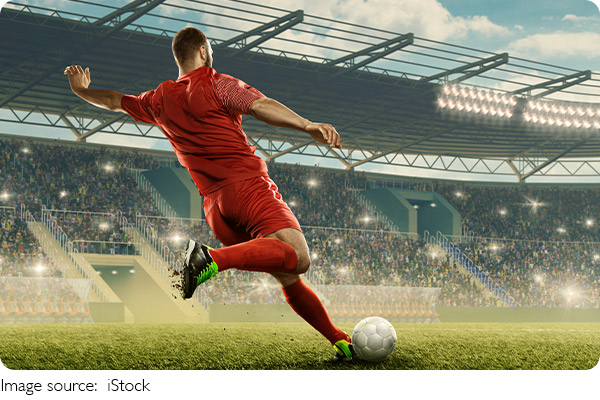Power of Feet in Football!

Football, known as soccer in some countries, is often described as a foot-based sport—but what exactly does this mean?
The sport is centered around the skill, precision, and control that players have over the ball using only their feet, with the occasional use of other body parts such as the head, chest, and legs.
However, it's the foot that drives almost every action on the field. Understanding the role of the foot in football helps us appreciate the level of skill required, as well as the unique aspects of this global sport!
1. The Central Role of the Foot in Ball Control
Football is first and foremost about controlling the ball with your feet. Players are trained to use various parts of the foot to manipulate the ball: the inside for precise passing, the outside for quick changes of direction, and the sole for stopping or turning the ball. The ability to trap, control, and dribble the ball with feet is a fundamental skill.
2. Dribbling: Footwork at Its Best
Dribbling is one of the most dynamic aspects of football, and it revolves entirely around the feet. Dribbling is the act of running while continuously controlling the ball with quick touches, often while trying to evade defenders. Elite players are able to dribble at high speeds, using their feet to change directions rapidly, accelerate, and even create feints that confuse opponents.
The art of dribbling is a clear example of how vital foot coordination and control are in football. It's not just about moving the ball, it's about maintaining dominance over it while navigating the pressure of a defender.
3. Kicking: The Foot's Power in Passing and Scoring
The foot's role in football goes beyond just controlling the ball, it also drives the action of passing and shooting. Kicking the ball accurately and powerfully is a core skill, whether it's a short pass to a teammate or a long-range strike toward goal.
Precision is key—players use the inside of the foot for short, accurate passes, while they may strike the ball with the laces (the top part of the foot) to generate more power. Scoring goals is a direct result of a well-executed strike, and the foot's ability to connect with the ball at the right angle and with the right power often determines whether a goal is scored.
4. Footwork in Defense: Stopping Attacks
Defenders also rely heavily on their feet to intercept passes, block shots, and tackle opponents. A well-timed tackle can win the ball back for a team, and this is typically done using the feet, either by a sliding tackle or a well-executed foot-block.
Defenders also use their foot skills to dribble the ball away from attackers or pass it to a teammate. Thus, footwork in defense requires a combination of timing, skill, and agility, making defenders just as reliant on their feet as attackers.
5. Goalkeeping: Foot Usage Beyond the Hands
While goalkeepers are mostly known for using their hands to stop shots, their feet play an equally important role in their ability to distribute the ball and control the game. Modern goalkeepers are expected to be adept with their feet—whether it's making a precise goal kick, distributing the ball to defenders, or even using their feet to block close-range shots.
In fact, many of the world's best goalkeepers are praised for their footwork in both distributing the ball under pressure and making clearances when required.

6. The Evolution of Footwear: Enhancing Foot Skills
The development of football boots has also had a significant impact on the way players use their feet. The evolution of boots from heavy leather shoes to lightweight, specialized footwear has allowed players to have more control over the ball.
Modern boots are designed with different types of cleats (studs) depending on the playing surface, providing better grip and maneuverability. The material used in football boots now incorporates advanced synthetics that allow players to strike the ball with precision while offering comfort and support to the foot during long matches.
7. Injury Risks: Foot-Related Challenges
While feet are essential for playing football, they are also prone to injuries. The constant running, rapid changes in direction, and repeated impact from striking the ball put significant stress on the foot and ankle.
Common injuries include sprained ankles, fractures, and stress fractures, often caused by sudden pivots, improper footwear, or excessive training. Injury prevention strategies, such as proper footwear, strengthening exercises, and rest, are crucial to keeping players' feet in top condition.
8. Footwork and Global Popularity
What makes football stand out from other sports is how it unites people through the universal skill of foot control. The sport is played all over the world, from local street matches to international tournaments, and it's the consistent use of feet in every match that links players of all ages and backgrounds.
No matter where you play, the same basic techniques of footwork—controlling, passing, dribbling, and shooting—apply, making football a sport accessible to anyone with a ball and a pair of feet.
Football's identity is rooted in the foot. From the moment a player receives the ball to the last second of a match, it's the foot that makes the game happen. Whether it's a beautiful pass, a stunning goal, or a brilliant defensive move, everything in football comes down to the feet. This reliance on foot skills makes football a unique, technical, and exhilarating sport to play and watch. Without the foot, there would be no football!

 · Sport Team
· Sport Team